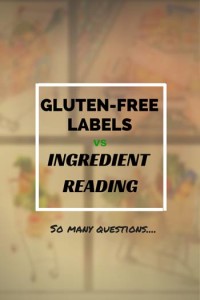 Here are a few questions for you about gluten free labels:
Here are a few questions for you about gluten free labels:
- Do you look for gluten free labels on packages?
- Are you a die-hard ingredient reader?
- BOTH?
- When you shop, do you need the gluten free label in order to purchase that product?
I am one of the first to tell you that seeing the words gluten free on a product, definitely eases the mind (*there are no regulations right now for companies to follow regarding gluten free labeling. But starting August 5th that will change with the Food and Drug Administration’s voluntary gluten-free labeling rule).
I have been giving this issue (reading the ingredient labels versus depending on the gluten-free label) some thought. Now I have a few questions:
Will I lose my gluten-free, ingredient-reading mojo if I constantly rely on the words “gluten free” on the product’s box?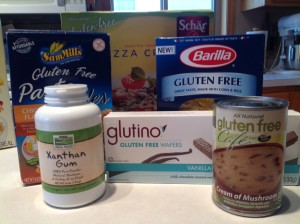
Hopefully not! I suspect many folks, like me, appreciate the gluten free label. But, let’s face it, we are a suspicious and cautious bunch–I presume most of us still take a quick peek at the ingredients as well. Hey, you never know when there could be a mistake (like when a few varieties of Boulder Canyon Malt Vinegar Chips were incorrectly labeled gluten free).
I recommend we rely on both: the gluten free label and ingredients, even after the rule goes into effect in August.
Once this rule is enacted, will newly diagnosed folks not need to learn the basics of label reading because the information will be spoon fed?
Again, in my opinion, hopefully not! Knowing what safe and unsafe ingredients are in the gluten-free diet is extremely important. Double checking the gluten free claim by looking at the ingredients would be a good habit for all of us to get into.
Should I avoid buying foods without gluten free labels even though the ingredients listed are safe?
First off, the gluten free labeling rule by the FDA is voluntary. So that means there will be foods labeled gluten free AND foods that are (or could very well be) gluten free that won’t be labeled because the company decided not to go that route.
Even though this is not a food, I want to point out that Chapstick is like this. This winter the company confirmed with me that its ingredients are gluten free and the company doesn’t add gluten to the products, but since they don’t test the finished product, they won’t label it as gluten free.
So knowing this, can we still eat non-GF labeled products with gluten free ingredients?
The FDA says,
“Some manufacturers may have to specially process, or reformulate foods in order for them to be free of gluten and to be eligible to bear a gluten-free labeling claim. Producers of foods that are by nature free of gluten (e.g., bottled spring water, fresh fruits and vegetables, and fresh seafood) may not choose to label these foods gluten-free even though the foods could be consumed as part of a gluten-free diet.
For foods that are by nature free of gluten, but are at high risk of gluten cross-contact (e.g., products made from grains, legumes, and seeds), the appearance of a gluten-free claim on the labels would provide consumers with the expectation that any gluten present is less than 20 ppm. Persons with celiac disease or who are otherwise sensitive to gluten should seek the advice of their health care providers for selecting appropriate foods they can consume following a gluten-free diet.”
What about products that have gluten free ingredients but are more processed, like the ingredients in corn meal pictured below. That, you will have to investigate and decide on your own.
For example, a few weeks ago, I called General Mills when there was a discussion about Chocolate Lucky Charms being gluten free. The ingredients showed no gluten-containing items. But when I called the company, the associate told me, “We label gluten free if it is gluten free. If there is no gluten free label on it, we can’t guarantee it is gluten free.”
This answer could mean a few things: they may not test the finished product, they may not worry about the source/cross contamination of incoming ingredients, or maybe they are producing it in a facility with wheat products and want to protect themselves.
So do you go for it? Good question! I will leave that one up to you.
Bottom line: The safest decision is probably to purchase products with the gluten free label.
But consider this: you may be limiting your options by only searching for the GF label. You can opt to keep your eyes peeled in the grocery store and look at the ingredients. If it looks safe, and you still have questions about a product, be sure to contact the company for clarification.
The GlutenFreeWatchdog.org site tests both products with and without gluten free labels. I am not affiliated with this site, but I am a member. By joining this service members get additional information about products like Kix, which were recently tested for gluten content, but are not labeled gluten free.
Am I the only one who has these questions rifling around in their brain? Hopefully this helps you if you were wondering the same thing.
If you have additional questions about gluten free labels or ingredient reading, contact your medical provider or dietitian.
Tags: celiac, gluten-free, ingredient, label, labeling, list, shopping
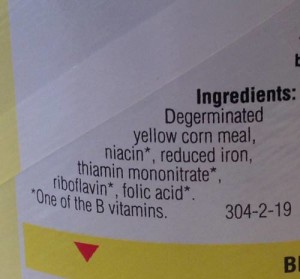
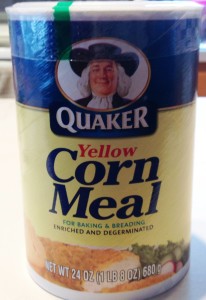
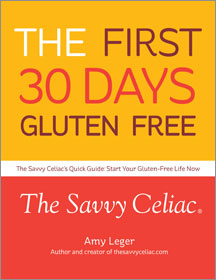

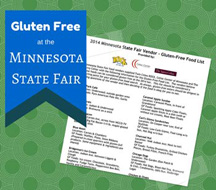
March 28th, 2014 at 10:33 am
I can’t imagine limiting myself to products labeled GF – I think there are a LOT of safe products out there that don’t have the GF label.
So, yes, I look for the GF label, but I definitely read the ingredients if I don’t find it. I HATE making phone calls, though, so if it’s got something ambiguous like the infamous “natural flavors,” I’ll usually give it a miss. Natural flavors are the bane of my gluten-free existence.
March 28th, 2014 at 10:42 am
I couldn’t agree more with the “Natural flavors are the bane of my gluten-free existence” comment. Thanks for sharing!
April 14th, 2014 at 1:34 pm
Thanks, Amy, for this post! I am still getting used to knowing exactly what words to look for when reading labels as my son was only diagnosed 6 months ago. I still question things like maltodextrin and whey, so if I see “gluten free” on the label, it eases my mind.